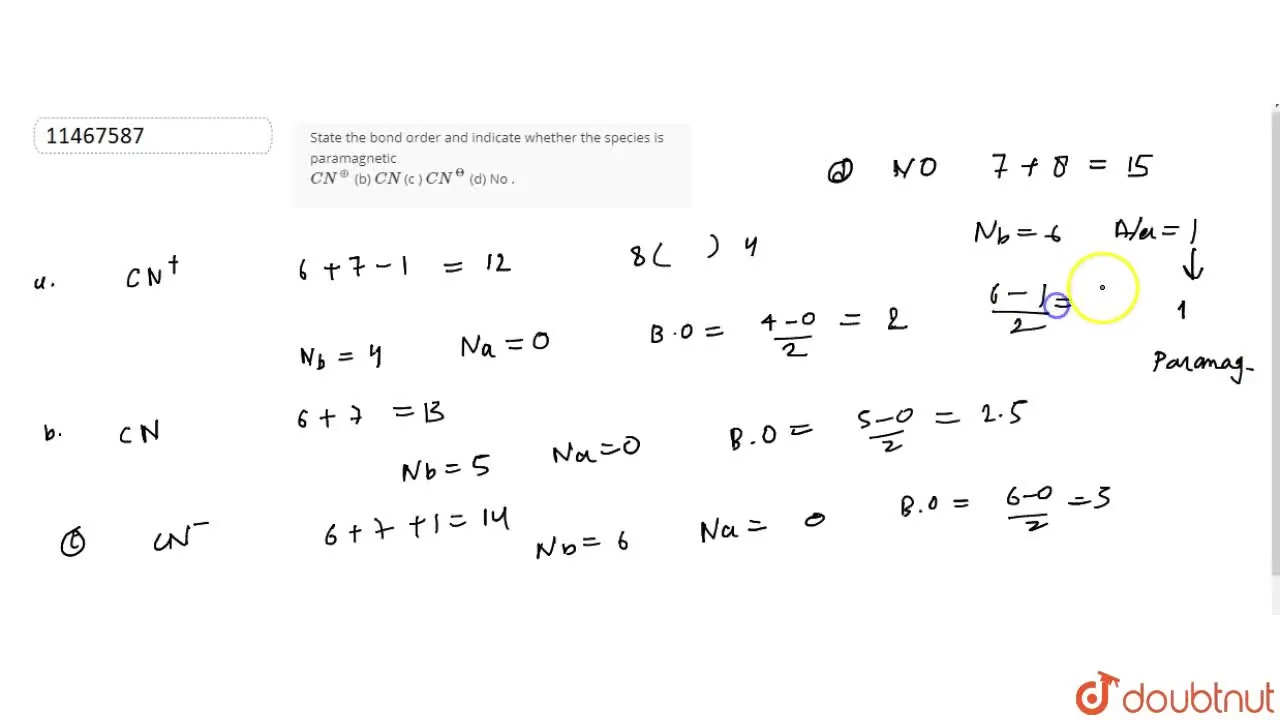State the bond order and indicate whether the species is paramagnetic
CN⊕ (b) CN (c ) CNΘ (d) No .
CN⊕ Total number of e−'s=6+7−1=12
Remaining pe−'s=12−8=4
Nb=4,Na=0
Bond order =12(4−0)=2
Number of unpaired e−'s=0 therefore diagmagnetic
CN Total electrons =6+7=13
Remaining pe−'s=13−8=5
Nb=5,Na=0
Bond order =12(5−0)=25
Number of unpaired e−'s=1 therefore paramagnetic
( c) CNΘ Total electrons =6+7+1=14
Remaining Nb=6,Na=0
Bond order =12(6−0)=3
Number e−'s Zero, therefore, diamagnetic
(d) NO: Total electrons =7+8=15
Remaining pe−'s=15−8=7
Bond order =12(6−1)=2.5
Number of unpaired e−'s 1, therefore paramagnetic .
Related Playlists
- BOOK - CENGAGE CHEMISTRYCHAPTER - CHEMICAL BONDING AND MOLECULAR STRUCTUREEXERCISE - Ex 2 .2 Subjective (Intermolecular Forces And H-Bonding)7videos
CHEMICAL BONDING AND MOLECULAR STRUCTURE
- BOOK - CENGAGE CHEMISTRYCHAPTER - CHEMICAL BONDING AND MOLECULAR STRUCTUREEXERCISE - Ex 2 .2 Subjective (Molecular Orbital Theory)4videos
CHEMICAL BONDING AND MOLECULAR STRUCTURE
- BOOK - CENGAGE CHEMISTRYCHAPTER - CHEMICAL BONDING AND MOLECULAR STRUCTUREEXERCISE - Archives Subjective15videos
CHEMICAL BONDING AND MOLECULAR STRUCTURE
- BOOK - CENGAGE CHEMISTRYCHAPTER - ATOMIC STRUCTUREEXERCISE - Concept Applicationexercise(4.3)19videos
ATOMIC STRUCTURE
- BOOK - CENGAGE CHEMISTRYCHAPTER - CHEMICAL EQUILIBRIUMEXERCISE - Archives (Subjective)11videos
CHEMICAL EQUILIBRIUM
Similar Questions
What is the bond order of CN− specie?
View SolutionBond order and magnetic nature of CN− are respectively
View SolutionWrite the Lewis structure for CNΘ ion .
View SolutionA triple bond is found in which of the following species?
(P) CO
(Q) C2H2
(R) CN−View SolutionHow many of the following species are paramagnetic?
N+2,O−2,B2,C2,CN−,NO+,CO,H−2,He+2View SolutionWhich of the following species have same bond order and same shape
(a) NΘ3 (b) O3 (c ) CO2 (d) NOΘ2.View SolutionCopper sulphate solution reacts with KCN to give
(a) Cu(CN)2
(b) CuCN
(c ) K2[Cu(CN)4]
(d) K3[Cu(CN)4] .View SolutionWhich of the following species have the same bond order?
(A) CN− and CN+
(B) O−2 and CN−
(C) NO+ and CN−
(D) CN− and NO−View SolutionConsider the following species and find the total number of species which have fractional bond order : O+2 , CO,B2 , O−2, NO+ , He+2 , C2+2, CN− , N−2
View SolutionThe common features anong the species CN−,CO and NO+ are :
View Solution


